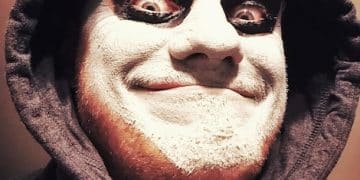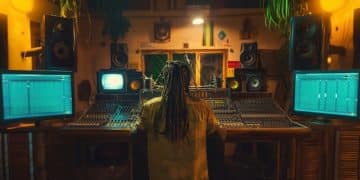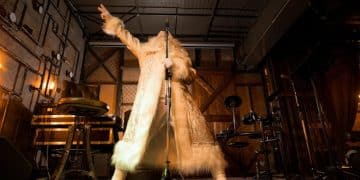The Power of Silence: Unpacking Nonverbal Storytelling in ‘Playtime’ (1967)

The Power of Silence: Analyzing the Nonverbal Storytelling in ‘Playtime’ (1967)’ reveals how Jacques Tati crafted a comedic masterpiece relying on visual gags, sound design, and intricate set pieces instead of dialogue, offering a unique cinematic experience.
Have you ever considered the profound impact of silence in cinema? In Jacques Tati’s ‘Playtime’ (1967), silence isn’t merely the absence of sound; it’s a powerful narrative tool that shapes the entire viewing experience. What can be learned from its nonverbal storytelling?
Let’s delve into The Power of Silence: Analyzing the Nonverbal Storytelling in ‘Playtime’ (1967)’, uncovering Tati’s genius in creating a film that transcends language barriers and speaks volumes through its meticulous visual composition and innovative sound design. We will examine the ways in which Tati used silence and nonverbal cues to create humor, convey meaning, and engage the audience in a truly unique way.
Understanding Tati’s Vision: Less Talk, More Observation
Jacques Tati, a visionary filmmaker, challenged conventional cinematic norms with ‘Playtime’ (1967). His vision extended beyond mere entertainment, aiming to provoke observation and reflection through a unique blend of visual comedy and social commentary.
Tati’s Critique of Modernity
Tati’s films frequently satirized the dehumanizing aspects of modern society. ‘Playtime’ (1967) is perhaps his most ambitious exploration of this theme, showcasing a sterile, ultra-modern Paris that prioritizes efficiency over human connection.
The Role of the Spectator
Tati transforms the audience into active observers. By minimizing dialogue and emphasizing visual gags, he encourages viewers to engage with the film on a deeper level, noticing subtle details and drawing their own conclusions.
- Tati uses long takes to allow viewers to explore the frame.
- Physical comedy replaces verbal jokes, making the humor universal.
- The film lacks a traditional plot, reflecting the chaotic nature of modern life.
- Sound design is meticulously crafted to enhance the visual gags and create a sense of disorientation.
Tati’s vision for ‘Playtime’ was to create a cinematic experience that resonated with audiences through visual storytelling, compelling observation, and subtle social commentary. The Power of Silence: Analyzing the Nonverbal Storytelling in ‘Playtime’ (1967)’ offers a glimpse into this creative choice.

The Art of Nonverbal Communication in ‘Playtime’
In ‘Playtime’ (1967), nonverbal communication isn’t just a stylistic choice; it’s the backbone of the narrative. Tati masterfully uses visual cues and soundscapes to convey meaning, create humor, and engage the audience. Understanding the art of nonverbal communication is key to grasping the film’s brilliance.
Body Language and Expression
Tati’s characters rely heavily on body language and facial expressions to communicate. Their gestures, postures, and reactions often speak louder than words, revealing their personalities and relationships.
Visual Gags and Slapstick
Physical comedy takes center stage in ‘Playtime’ (1967). Tati employs a variety of visual gags and slapstick routines to generate laughter and highlight the absurdity of modern life.
Ultimately, the nonverbal elements in ‘Playtime’ create a rich and engaging cinematic experience that transcends language barriers. Analyzing these aspects reveals The Power of Silence: Analyzing the Nonverbal Storytelling in ‘Playtime’ (1967)’.
Decoding Soundscapes: Beyond Dialogue in ‘Playtime’
While ‘Playtime’ (1967) is renowned for its lack of dialogue, it’s far from silent. The film’s intricate sound design plays a crucial role in shaping the narrative and enhancing the comedic effect. The soundscapes within the film are essential for understanding Tati’s vision.
Ambient Sounds and Urban Noise
Tati meticulously layers ambient sounds and urban noises to create a realistic, yet often chaotic, soundscape. The constant hum of the city, the clatter of footsteps, and the echoes of conversations all contribute to the film’s immersive quality.
Sound as a Comedic Device
Sound is frequently used as a comedic device in ‘Playtime’ (1967). Exaggerated sound effects, unexpected noises, and the strategic use of silence all contribute to the film’s humor.
- The echoing footsteps in the sterile office building emphasize the lack of human presence.
- The malfunctioning door buzzer creates a recurring gag that highlights the absurdity of modern technology.
- The sudden bursts of music in the Royal Garden restaurant add to the chaotic atmosphere.
By carefully crafting the soundscape, Tati creates a world that is both familiar and surreal, inviting viewers to listen closely and engage with the film on multiple levels. The film showcases The Power of Silence: Analyzing the Nonverbal Storytelling in ‘Playtime’ (1967)’ with its emphasis on non-dialogue sounds.
The Significance of Set Design in ‘Playtime’
The elaborate and meticulously designed sets of ‘Playtime’ (1967) are integral to the film’s narrative. Tati’s use of architecture and urban spaces conveys his social commentary and enhances the comedic impact.
Modernist Architecture as a Character
The film’s modernist architecture isn’t just a backdrop; it’s a character in itself. The sterile, repetitive designs of the buildings reflect the dehumanizing aspects of modern society.
Creating a Playground for Comedy
Tati transforms the urban landscape into a playground for physical comedy. The film’s sets are filled with obstacles, hidden corners, and unexpected features that provide ample opportunities for visual gags.

The film’s sets work together to enhance the film’s visual storytelling and comedic effect. The attention to detail in ‘Playtime’ really showcases The Power of Silence: Analyzing the Nonverbal Storytelling in ‘Playtime’ (1967)’.
‘Playtime’s Enduring Legacy: Influencing Comedy and Film
‘Playtime’ (1967), despite its initial commercial failure, has had a lasting impact on cinema. Its innovative approach to comedy, visual storytelling, and sound design continues to influence filmmakers today.
Technological Challenges and Cinematic Innovation
The production of ‘Playtime’ was fraught with technological challenges. Tati’s insistence on building elaborate sets and filming in 70mm required significant financial investment and technical expertise.
A Lasting Influence on Visual Comedy
‘Playtime’s influence can be seen in the works of many contemporary filmmakers. Its emphasis on visual comedy, meticulous set design, and innovative sound design paved the way for new approaches to cinematic storytelling.
- Wes Anderson’s films often feature intricately designed sets and a similar sense of whimsical humor.
- The visual gags and physical comedy in ‘Playtime’ resonate with the work of Charlie Chaplin and Buster Keaton.
- The film’s critique of modern society continues to be relevant in an increasingly digital and interconnected world.
With its influence on future film, it’s clear that The Power of Silence: Analyzing the Nonverbal Storytelling in ‘Playtime’ (1967)’ has helped change modern comedy, making ‘Playtime’ a cinematic treasure.
| Key Point | Brief Description |
|---|---|
| 🎬 Nonverbal Storytelling | Tati relies on visual gags and sound design rather than dialogue. |
| 🏢 Modernist Critique | The film satirizes the dehumanizing aspects of modern architecture. |
| 🔊 Innovative Sound | Soundscapes enhance comedy and create immersive experience. |
| 🎭 Enduring Legacy | ‘Playtime’ has influenced future filmmakers with unique storytelling. |
Frequently Asked Questions
Tati’s unique approach in ‘Playtime’ minimizes dialogue, emphasizing instead visual communication and sound design as primary narrative tools. This creates a universal and engaging cinematic experience. This approach showcases The Power of Silence: Analyzing the Nonverbal Storytelling in ‘Playtime’ (1967)’.
‘Playtime’ critiques modern society through its depiction of sterile, dehumanizing architecture and technology, highlighting the isolation and lack of genuine connection in modern urban environments.
Sound in ‘Playtime’ is crucial, replacing dialogue with ambient noises, comedic sound effects, and strategic silence. These elements enhance the film’s humor and immersive quality making The Power of Silence: Analyzing the Nonverbal Storytelling in ‘Playtime’ (1967)’ a sound-driven film.
The set design in ‘Playtime’ is significant because it acts as a character itself, reflecting the sterile and repetitive nature of modern architecture, while also providing a playground for physical comedy and visual gags.
‘Playtime’ has influenced later filmmakers with its emphasis on visual comedy, meticulously designed sets, and innovative sound design, paving the way for new approaches to cinematic storytelling. The Power of Silence: Analyzing the Nonverbal Storytelling in ‘Playtime’ (1967) ‘ is truly long-lasting.
Conclusion
In conclusion, The Power of Silence: Analyzing the Nonverbal Storytelling in ‘Playtime’ (1967)’ reveals Tati’s brilliance in crafting a visually rich and humorous critique of modern society. Its enduring impact on cinema is a testament to his innovative approach to filmmaking through the silencing of dialogue.
By minimizing dialogue and maximizing visual and auditory elements, Tati created a timeless classic that continues to resonate with audiences worldwide due to the movie’s emphasis on the visual above all else. His masterful storytelling choices influence visual comedy to this day.





